Toki Pona
Toki Pona is a philosophical, artistic, and constructed language known for its small vocabulary. It was created by Canadian linguist and translator Sonja Lang[1] for the purpose of simplifying thoughts and communication. It was first published online in 2001 as a draft,[2] and later in complete form in the book Toki Pona: The Language of Good in 2014.[3][4] A small community of speakers developed in the early 2000s.[5][6] While activity mostly takes place online in chat rooms, on social media, and in other groups, there were a few organized in-person meetings during the 2000s[2] and 2010s.
| Toki Pona | |
|---|---|
| toki pona | |
 | |
| Pronunciation | [ˈtoki ˈpona] |
| Created by | Sonja Lang |
| Date | 2001 |
| Setting and usage | testing principles of minimalism, the Sapir–Whorf hypothesis and pidgins |
| Purpose | constructed language, combining elements of the subgenres personal language and philosophical language |
| Latin script; sitelen pona (logographic); sitelen sitelen (logographic with an alphasyllabary for foreign words); and numerous other unofficial scripts | |
| toki pona luka (official) | |
| Sources | a posteriori language, with elements of English, Tok Pisin, Finnish, Georgian, Dutch, Acadian French, Esperanto, Croatian, Chinese |
| Language codes | |
| ISO 639-3 | None (mis) |
| Glottolog | None |
The underlying feature of Toki Pona is minimalism. It focuses on simple universal concepts, making use of very little to express the most. The language is isolating and has around 123 root words and 14 phonemes[1][2] that are easy to pronounce across different languages. However, it was not created to be an international auxiliary language. Inspired by Taoist philosophy, the language is designed to help users concentrate on basic things and to promote positive thinking, in accordance with the Sapir–Whorf hypothesis. Despite the small vocabulary, speakers are able to understand and communicate with each other, mainly relying on context and combinations of several words to express more specific meanings.
Etymology
The name of the language is constituted by toki (language),[7] derived from Tok Pisin tok, which itself comes from English talk; and pona (good/simple), from Esperanto bona (good),[7] ultimately from Latin bonus.
Purpose
Sonja Lang (née Elen Kisa) started developing Toki Pona as a way of simplifying her thoughts during depression.[5][8]
One of the language's main goals is a focus on minimalism. It is designed to express maximal meaning with minimal complexity.[9] Like a pidgin, it focuses on simple concepts and elements that are universal among cultures. It has 120–125 root words, and 14 phonemes devised to be easy to pronounce for speakers of various language backgrounds.[1][2][5]
Inspired by Taoist philosophy, another goal of Toki Pona is to help its users focus on the essentials by reducing complex concepts into basic elements and remove complexity from the thought process.[1][10] From these simple notions, more complex ideas can be created by simple combining.[9] This allows the users to see the fundamental nature and effect of the ideas expressed.
Like the Sapir–Whorf hypothesis, which states that a language changes the way its speakers think and behave,[5][10] Toki Pona tries to induce positive thinking.[11]
Another aim of the language is for the users to become aware of the present moment and pay more attention to the surroundings and the words people use.[1] According to its author, it is meant to be "fun and cute".[12]
Although it was not intended as an international auxiliary language,[11] people from all around the world use it for communication.[1]
History
An early version of the language was published online in 2001 by Sonja Lang, and it quickly gained popularity.[5] Early activity took place in a Yahoo! group. Members of the group discussed the language with one another in English, Toki Pona, and Esperanto, proposed changes, and talked about the resources on the tokipona.org site. At its peak member count, the group had a little over 500 members. Messages in the group were archived in the Toki Pona forum using phpBB.
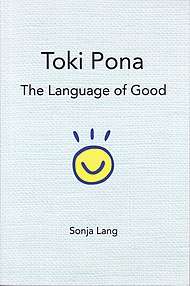
Lang later released an official book on the language, Toki Pona: The Language of Good, in 2014.[3] It is also sometimes referred to as pu in the Toki Pona community.[13] In 2016, the book was also published in French.[14] Although other resources for the language have been created by the community, the major sources for learning continue to be Lang's book and online lessons developed by Bryant Knight or "jan Pije", an early adopter of Toki Pona.[10][14]
In 2008 an application for an ISO 639-3 code was rejected, with a statement that the language was too young.[15] Another request was rejected in 2018 as the language "does not appear to be used in a variety of domains nor for communication within a community which includes all ages".[16]
Toki Pona was the subject of some scientific works,[2] and it has also been used for artificial intelligence and software tools,[14] as well as a therapeutic method for eliminating negative thinking by having patients keep track of their thoughts in the language.[5] In 2010 it was chosen for the first version of the vocabulary for the ROILA project. The purpose of the study was to investigate the use of an artificial language on the accuracy of machine speech recognition, and it was revealed that the modified vocabulary of Toki Pona significantly outperformed English.[17]
Phonology and phonotactics
Inventory
Toki Pona has nine consonants (/p, t, k, s, m, n, l, j, w/) and five vowels (/a, e, i, o, u/),[2][5] shown here with the International Phonetic Alphabet symbols. Stress falls on the initial syllable of a word. There are no diphthongs, contrasting vowel length, consonant clusters (except those starting with the nasal coda), or tones.[2] Both its sound inventory and phonotactics are compatible with the majority of human languages, and are therefore readily accessible.[3]
| Labial | Coronal | Dorsal | |
|---|---|---|---|
| Nasal | m | n | |
| Stop | p | t | k |
| Fricative | s | ||
| Approximant | w | l | j |
| Front | Back | |
|---|---|---|
| Close | i | u |
| Mid | e | o |
| Open | a | |
Distribution
The statistical vowel spread is fairly typical when compared with other languages.[2] Counting each root once, 32% of vowels are /a/, 25% are /i/, with /e/ and /o/ a bit over 15% each, and 10% are /u/.[2] The usage frequency in a 10kB sample of texts was slightly more skewed: 34% /a/, 30% /i/, 15% each /e/ and /o/, and 6% /u/.[18]
Of the syllable-initial consonants, /l/ is the most common, at 20% total; /k, s, p/ are over 10%, then the nasals /m, n/ (not counting final N), with the least common, at little more than 5% each, being /t, w, j/. The high frequency of /l/ and low frequency of /t/ is somewhat unusual among the world's languages.[2]
Syllable structure
Syllables are of the form (C)V(N), i.e. optional consonant + vowel + optional final nasal, or V, CV, VN, CVN. The consonant is obligatory in syllables that are not word-initial.[14] As in most languages, CV is the most common syllable type, at 75% (counting each root once). V and CVN syllables are each around 10%, while only 5 words have VN syllables (for 2% of syllables).[2]
Most roots (70%) are disyllabic; about 20% are monosyllables and 10% trisyllables. This is a common distribution, and similar to Polynesian.[2]
Phonotactics
The following sequences are not allowed: */ji, wu, wo, ti/, nor may a syllable's final nasal occur before /m/ or /n/ in the same root.[2][14]
Proper nouns are usually converted into Toki Pona proper adjectives using a set of guidelines. The native, or even colloquial, pronunciation is used as the basis for the subsequent sound conversion. Thus, England or English become Inli and John becomes San.[19]
Allophony
The nasal at the end of a syllable can be pronounced as any nasal stop, though it is normally assimilated to the following consonant. That is, it typically occurs as an [n] before /n/, /t/, /s/ or /l/, as an [m] before /m/, /p/ or /w/, as an [ŋ] before /k/, and as an [ɲ] before /j/.[2]
Because of its small phoneme inventory, Toki Pona allows for quite a lot of allophonic variation. For example, /p t k/ may be pronounced [b d ɡ] as well as [p t k], /s/ as [z] or [ʃ] as well as [s], /l/ as [ɾ] as well as [l], and vowels may be either long or short.[2]
Writing systems
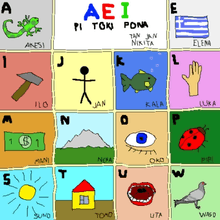
14 Latin letters, a e i j k l m n o p s t u w, are used to write the language. They have the same values as in the International Phonetic Alphabet:[2] j sounds like English y (as in German) and the vowels are like those of Spanish. Capital initials are used to mark proper adjectives, while Toki Pona roots are always written with lowercase letters, even when they start a sentence.[2][9]

Besides the Latin alphabet, which is the most convenient and most used way of writing the language,[2] two logographic writing systems, sitelen pona and sitelen sitelen, were later introduced and included in Toki Pona: The Language of Good. The former, in which each word is represented by a symbol, was devised as an alternative by Lang herself.[4] It has been described as "a hieroglyphic-like script that makes use of squiggles and other childlike shapes"[20] . Proper names are written inside a cartouche-like symbol using a series of symbols, where each symbol represents the first letter of its word. Symbols representing a single adjective may be written inside or above the symbol for the preceding word that they modify. The symbol of the language is written in sitelen pona,[20] with the symbol for pona written inside the symbol for toki.
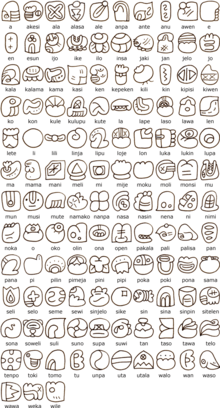
The latter system, sitelen sitelen, was created by Jonathan Gabel. It is more elaborate and visually resembles the Mayan script.[13] This non-linear system uses two separate methods to form words: logograms representing words and an alphasyllabary for writing the syllables (especially for proper names). The difficulty of using this system along with its appealing design is a way for people to slow down and explore how not only the language but also the method of communication can influence thinking.[4][21]
Individuals from the community have also adapted many other scripts to write Toki Pona.[2]
Grammar
Toki Pona's word order is subject–verb–object.[10][22] The word li introduces predicates, e introduces direct objects, prepositional phrases follow the objects, and la phrases come before the subject to add additional context.[14]
Some roots are grammatical particles, while others have lexical meanings. The lexical roots do not fall into well defined parts of speech; rather, they may be used generally as nouns, verbs, modifiers, or interjections depending on context or their position in a phrase. For example, ona li moku may mean "they ate" or "it is food".[2][10]
Sentence structures
A sentence may be an interjection, statement, wish/command, or question.
For example, interjections such as a, ala, ike, jaki, mu, o, pakala, pona, toki, etc. can stand alone as a sentence.[10]
Statements follow the normal structure of subject-predicate with an optional la phrase at the beginning. The word li always precedes the predicate unless the subject is a mi or sina. The direct object marker e comes before direct objects. More li and e markers can present new predicates or direct objects. Vocative phrases come before the main sentence and are marked with o at the end of the phrase, after the addressee.[10][14]
In commands, the word o comes before a verb to express a second person command. It can also replace li, or come after the subjects mi or sina, to express wishes.
There are two ways to form yes-no questions in Toki Pona. The first method is to use the "verb ala verb" construction in which ala comes in between a duplicated verb, auxiliary verb, or other predicators.[10] Another way to form a yes-no question is to put "anu seme?" (lit. or what?) at the end of a sentence. Questions cannot be made by just putting a question mark at the end of a sentence.
Non-polar questions are formed by replacing the unknown information with the interrogative word seme.[14]
Pronouns
Toki Pona has basic pronouns: mi (first person), sina (second person), and ona (third person).[23]
The pronouns do not specify number or gender. Therefore, ona can mean "he", "she", "it", or "they". In practice, Toki Pona speakers use the phrase mi mute to mean "we", though the number is often discernible from context and thus only mi is necessary. Likewise, ona mute may mean "they" and sina mute would mean "you" (plural).[2]
Whenever the subject of a sentence is either of the unmodified pronouns mi or sina, then li is not used to separate the subject and predicate.[14]
Nouns
With such a small root-word vocabulary, Toki Pona relies heavily on noun phrases, where a noun is modified by a following root, to make more complex meanings.[8] A typical example is combining jan (person) with utala (fight) to make jan utala (soldier, warrior).
Nouns do not decline according to number. jan can mean "person", "people", "humanity", or "somebody", depending on context.[2]
Toki Pona does not use isolated proper nouns; instead, they must modify a preceding noun. For this reason, they may be called "proper adjectives" or simply “proper words” instead of “proper nouns”. For example, names of people and places are used as modifiers of the common roots for "person" and "place", e.g. ma Kanata (lit. "Canada country") or jan Lisa (lit. "Lisa person").[2]
Modifiers
Phrases in Toki Pona are head-initial; modifiers always come after the word that they modify.[10] Therefore, soweli utala, literally "animal of fighting", is a "fighting animal", whereas utala soweli, literally "fighting of animal", means "animal war".[2]
When a second modifier is added to a phrase, for example jan pona lukin, it modifies all that comes before it, so ((jan pona) lukin) = "friend watching", rather than (jan (pona lukin)), "person good-looking".[2]
The particle pi is placed after the head and before the modifiers, to group the modifiers into another phrase that functions as a unit to modify the head, so jan pi pona lukin = (jan pi (pona lukin)), "good-looking person". In this case, lukin modifies pona and pona lukin as a whole modifies jan.[2][14]
Demonstratives, numerals, and possessive pronouns come after the head like other modifiers.[2]
Verbs
Toki Pona does not inflect verbs according to person, tense, mood, or voice, as the language features no inflection whatsoever. Person is indicated by the subject of the verb; time is indicated through context or by a temporal adverb in the sentence.[2]
Prepositions are used in the predicate in place of a regular verb.[4][22]
Vocabulary
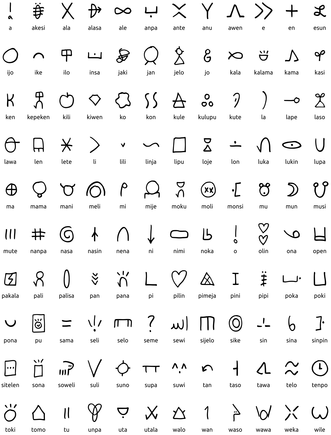
Toki Pona has around 123[1] root words.[24] Each is polysemous and covers a range of similar concepts,[13] so suli not only means "big" or "long", but also "important".[2] Their use relies heavily on context. To express more complex thoughts, the roots can be combined. For example, jan pona can mean friend, although it literally translates to "good/friendly person",[8] and telo nasa, which literally means "strange water" or "liquid of craziness", would be understood to mean "alcohol" or "alcoholic beverage" depending on the context. The verb "to teach" can be expressed by pana e sona, which literally means "to give knowledge".[2] Essentially identical concepts can be described by different words as the choice relies on the speaker's perception and experience.[3]

Colors
Toki Pona has five root words for colors: pimeja (black), walo (white), loje (red), jelo (yellow), and laso (blue and green).[1][2] Although the simplified conceptualization of colors tends to exclude a number of colors that are commonly expressed in Western languages, speakers sometimes may combine these five words to make more specific descriptions of certain colors. For instance, "purple" may be represented by combining laso and loje. The phrase laso loje means "a reddish shade of blue" and loje laso means "a bluish shade of red".[2]
Numbers
Toki Pona has root words for one (wan), two (tu), and many (mute). In addition, ala can mean zero, although its more literal meaning is "no" or "none," and ale "all" can express an infinite or immense amount.
The simplest number system uses these five roots to express any amount necessary. For numbers larger than two, speakers would use mute which means "many".[13]
A more complex system expresses larger numbers additively by using phrases such as tu wan for three, tu tu for four, and so on. This feature purposely makes it impractical to communicate large numbers.[13][25]
An alternate system for larger numbers, described in Lang's book, uses luka (literally "hand") to signify "five", mute (literally "many") to signify "twenty" and ale (literally "all") to signify "100". For example, using this structure ale tu would mean "102" and mute mute mute luka luka luka tu wan would signify "78".[26]
Roots history
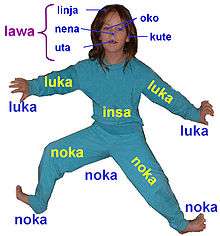
Some words have obsolete synonyms. For example, nena replaced kapa (protuberance) early in the language's development for unknown reasons.[27] Later, the pronoun ona replaced iki (he, she, it, they), which was sometimes confused with ike (bad).[25]
Similarly, ali was added as an alternative to ale (all) to avoid confusion with ala (no, not) among people who reduce unstressed vowels, though both forms are still used.
Originally, oko meant "eye" and lukin was used as a verb "see". In the book, the meanings were later merged into lukin, oko being the alternative.[4][14]
Words that have been simply removed from the lexicon include leko (block, stairs), monsuta (monster, fear), majuna (old), and pata (sibling).[27]
Besides nena and ona, which replaced existing roots, a few roots were added to the original 118: pan (grain, bread, pasta, rice), esun (market, shop, trade), alasa, (hunt, gather), kipisi, (to cut), and namako (extra, additional, spice), another word for sin (new).[28]
Words like kipisi, majuna and monsuta are now considered outdated because they were not included in the official book.[27]
Provenance
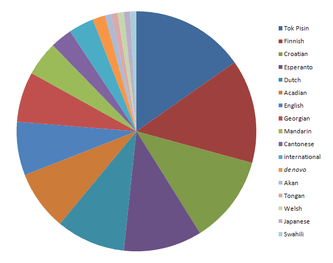
Most Toki Pona roots come from English, Tok Pisin, Finnish, Georgian, Dutch, Acadian French, Esperanto, Croatian, with a few from Chinese (Mandarin and Cantonese).[9][29]
Many of these derivations are transparent. For example, oko (eye) is identical to Slavic oko and similar to other cognates such as Spanish ojo, Italian occhio and English ocular; likewise, toki (speech, language) is similar to Tok Pisin tok and its English source talk, while pona (good, positive), from Esperanto bona, reflects generic Romance bon, buona, English bonus, etc. However, the changes in pronunciation required by the simple phonetic system often make the origins of other words more difficult to see. The word lape (to sleep, to rest), for example, comes from Dutch slapen and is cognate with English sleep; kepeken (to use) is somewhat distorted from Dutch gebruiken, and akesi from hagedis (lizard) is scarcely recognizable. [Because *ti is an illegal syllable in Toki Pona, Dutch di becomes si.][29]
Although only 14 roots (12%) are listed as derived from English, a large number of the Tok Pisin, Esperanto, and other roots are transparently cognate with English, raising the English-friendly portion of the vocabulary to about 30%. The portions of the lexicon from other languages are 15% Tok Pisin, 14% Finnish, 14% Esperanto, 12% Croatian, 10% Acadian French, 9% Dutch, 8% Georgian, 5% Mandarin, 3% Cantonese; one root each from Welsh, Tongan (an English borrowing), Akan, and an uncertain language (apparently Swahili); four phonesthetic roots (two which are found in English, one from Japanese, and one which was made up); and one other made-up root (the grammatical particle e).[29]
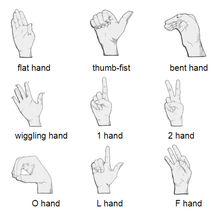
Signed Toki Pona
Signed Toki Pona, or toki pona luka, is a manually coded form of Toki Pona. Each word and letter has its own sign, which is distinguished by the hand shape, location of the hand on the body, palm or finger orientation, and the usage of one or both hands. Most signs are performed with the right hand at the required location. A few signs, however, are performed with both hands in a symmetrical way.
To form a sentence, each of the signs is performed using the grammar and word order of Toki Pona.[4]
Community
The language is fairly known among Esperantists, who often offer courses and conversation groups at their meetings.[2] In 2007, Lang reportedly said that at least 100 people speak Toki Pona fluently and estimated that a few hundred have a basic knowledge of the language.[5][30] One-hour courses of Toki Pona were taught on various occasions by the Massachusetts Institute of Technology during their Independent Activities Period.[5]
The language is used mainly online on social media, in forums, and other groups.[30] Users of the language are spread out across multiple platforms. A Yahoo! group existed from about 2002 to 2009, when it moved to a forum on a phpBB site.[31][32] For a short time there was a Wikipedia written in Toki Pona (called "Wikipesija"). It was closed in 2005[33] and moved to Wikia.
Two large groups exist on Facebook—one designated for conversation in Toki Pona and English, and the other for conversation in only Toki Pona.[34] In 2019, the most subscribed group, in which members communicate in both English and Toki Pona, had over 4,000 total members.[35][33]
Another influential group existing on Discord is called ma pona pi toki pona. It has over 1,500 members as of 2020.[36]
Sample texts
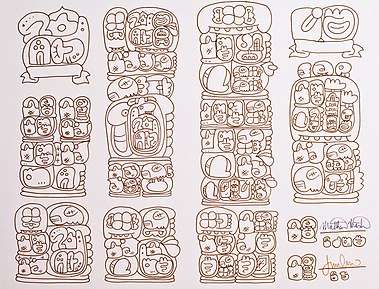
mama pi mi mute[2][9] (The Lord's Prayer, translated by Bryant J. Knight, 2005)
mama pi mi mute o, sina lon sewi kon.
nimi sina li sewi.
ma sina o kama.
jan o pali e wile sina lon sewi kon en lon ma.
o pana e moku pi tenpo suno ni tawa mi mute.
o weka e pali ike mi. sama la mi weka e pali ike pi jan ante.
o lawa ala e mi tawa ike.
o lawa e mi tan ike.
tenpo ali la sina jo e ma e wawa e pona.
Amen.
jan Meli o[38] (Ave Maria, translated by Tobias Merkle, 2020)
jan Meli o,
kon sewi li suli insa sina.
wan sewi li poka sina.
lon meli la, wan sewi li pona e sina.
kili pona pi insa sina li sewi Jesu.
jan Meli sewi o!
mama pi jan sewi o!
tenpo ni la, tenpo pi moli mi mute la,
o toki tawa wan sewi tan mi mute jan ike.
awen.
Article 1 of the Universal Declaration of Human Rights[39]
jan ali li kama lon nasin ni: ona li ken tawa li ken pali. jan ali li kama lon sama. jan ali li jo e ken pi pilin suli. jan ali li ken pali e wile pona ona. jan ali li jo e ken pi sona pona e ken pi pali pona. jan ali li wile pali nasin ni: ona li jan pona pi ante.
ma tomo Pape[40] (The Tower of Babel story, translated by Bryant J. Knight, 2005)
jan ali li kepeken e toki sama.
jan li kama tan nasin pi kama suno li kama tawa ma Sinale li awen lon ni.
jan li toki e ni: "o kama! mi mute o pali e kiwen. o seli e ona".
jan mute li toki e ni: "o kama! mi mute o pali e tomo mute e tomo palisa suli. sewi pi tomo palisa li lon sewi kon. nimi pi mi mute o kama suli! mi wile ala e ni: mi mute li lon ma ante mute".
jan sewi Jawe li kama anpa li lukin e ma tomo e tomo palisa.
jan sewi Jawe li toki e ni: "jan li lon ma wan li kepeken e toki sama li pali e tomo palisa. tenpo ni la ona li ken pali e ijo ike mute. mi wile tawa anpa li wile pakala e toki pi jan mute ni. mi wile e ni: jan li sona ala e toki pi jan ante".
jan sewi Jawe li kama e ni: jan li lon ma mute li ken ala pali e tomo.
nimi pi ma tomo ni li Pape tan ni: jan sewi Jawe li pakala e toki pi jan ali. jan sewi Jawe li tawa e jan tawa ma mute tan ma tomo Pape.
|
wan taso (2003)[41]
|
Alone
|
See also
References
- Morin, Roc (2015-07-15). "How to Say (Almost) Everything in a Hundred-Word Language". The Atlantic. Retrieved 2019-08-01.
- Blahuš, Marek (November 2011). Fiedler, Sabine (ed.). "Toki Pona: eine minimalistische Plansprache" [Toki Pona: A Minimalistic Planned Language] (PDF). Interlinguistische Informationen (in German). Berlin. 18: 51–55. ISSN 1432-3567.
- Thomas, Simon (2018-03-27). "Exploring Toki Pona: do we need more than 120 words?". Oxford Dictionaries. Archived from the original on 2019-05-11. Retrieved 2019-02-03.
- Lang, Sonja (2014). Toki Pona: The Language of Good. Tawhid. p. 134. ISBN 978-0-9782923-0-0.
- Roberts, Siobhan (2007-07-09). "Canadian has people talking about lingo she created". The Globe and Mail. Retrieved 2017-03-10.
- Јовановић, Тијана (Tiyana Yovanovich) (2006-12-15). "Вештачки језици" [Artificial languages]. Политикин Забавник (Politikin Zabavnik) (in Serbian) (2862). Archived from the original on 2007-06-10.
- "Toki Pona word origins". tokipona.org. 2009-09-28. Archived from the original on 2010-03-08.
- Dance, Amber (2007-08-24). "In their own words – literally / Babel's modern architects". Los Angeles Times. Archived from the original on 2013-01-03. Retrieved 2007-08-29.
- Rogers, Steven D. (2011). "Part I: Made-Up Languages – Toki pona". A Dictionary of Made-Up Languages. United States of America: Adams Media. ISBN 978-1440528170.
- Tomaszewski, Zach (2012-12-11). "A Formal Grammar for Toki Pona" (PDF). University of Hawai‘i. Retrieved 2019-09-21.
- Malmkjær, Kirsten (2010). "Artificial languages". The Routledge Linguistics Encyclopedia (3rd ed.). New York: Routledge. p. 34. ISBN 9780415424325. OCLC 656296619.
- Okrent, Arika (2009). "The Klingons, the Conlangers, and the Art of Language – 26. The Secret Vice". In the Land of Invented Languages. New York: Spiegel & Grau. ISBN 978-0-385-52788-0.
- Синящик, Анна (Anna Sinyashchik) (2018-01-03). "Коротко и ясно. Как искусственный язык учит фокусироваться на главном" [Briefly and Clearly. How an Artificial Language Teaches to Focus on What's Important]. Фокус (Focus) (in Russian).
- Fabbri, Renato (July 2018). "Basic concepts and tools for the Toki Pona minimal and constructed language". ACM Transactions on Asian and Low-Resource Language Information Processing. 0: 00:2. arXiv:1712.09359v3.
- "Change Request Documentation: 2007-011". iso639-3.sil.org. 2020. Retrieved 2020-06-05.
- "Change Request Documentation: 2017-035". SIL ISO 639-3. Retrieved 2019-01-10.
- Mubin, Omar; Bartneck, Christoph; Feijs, Loe (2010). "Towards the Design and Evaluation of ROILA: A Speech Recognition Friendly Artificial Language". Advances in Natural Language Processing. Lecture Notes in Computer Science. LNCS 6233/2010: 250–256. CiteSeerX 10.1.1.175.6679. doi:10.1007/978-3-642-14770-8_28. ISBN 978-3-642-14769-2 – via ResearchGate.
- "Phoneme frequency table / Ofteco de fonemoj". lipu pi toki pona pi jan Jakopo. Archived from the original on 2007-11-14.
- Lang, Sonja. Knight, Bryant (ed.). "Phonetic conversion of proper names". lipu pi jan Pije. Retrieved 2019-01-15.
- "Toki Pona – The language of good". Smith Journal. Melbourne, Australia. 2019-06-03. Retrieved 2019-10-20.
- Gabel, Jonathan (2019-10-20). "Lesson 1: Welcome". Jonathan Gabel. Retrieved 2019-10-20.
- "3. Toki Pona Text – Grammar and Vocabulary". Language Creation Society. Retrieved 2019-01-25.
- Martin, Matthew (2007-09-11). "Toki Pona: Pronouns unleashed". My Suburban Destiny. Retrieved 2019-01-25.
- Originally published 118 words in 2001, with several words added later.
- Yerrick, Damian (2002-10-23). "Toki Pona li pona ala pona? A review of Sonja Kisa's constructed language Toki Pona". Pin Eight. Retrieved 2007-07-20.
- "Numbers". tokipona.net. Retrieved 2019-01-26.
- Knight, Bryant (2017-08-31). "Extinct words". lipu pi jan Pije. Retrieved 2019-01-13.
- "Classic Word List (Improved!)". tokipona.net. Retrieved 2019-01-07.
- "Toki Pona Word Origins". UC Team. Retrieved 2019-01-12.
- Marsh, Stefanie (2007-09-06). "Now you're really speaking my language". The Times. London, England. p. 2.
- Martin, Matthew (2018-03-11). "Conlang SE". Fake languages by a fake linguist. Retrieved 2019-10-20.
- "tokipona Toki Pona". Yahoo! Groups. 2019-10-20. Archived from the original on 2013-04-30. Retrieved 2019-10-20.
- van Steenbergen, Jan (2018). "A new era in the history of language invention" (PDF). Linguapax Review.
- Knežević, Nenad (2018). "Constructed languages in the whirlwind of the digital revolution". Језик, књижевност и технологија / Language, Literature and Technology: Proceedings from the Sixth International Conference at the Faculty of Foreign Languages, 19–20 May 2017. Алфа БК универзитет (Alfa BK univerzitet): 16. ISBN 978-86-6461-023-0 – via ResearchGate.
- Zorrilla, Natalia C. (2018). "Still Hoping: The Relation of International Auxiliary Languages to Worldview and Perception". doi:10.31235/osf.io/sj24a – via SocArXiv. Cite journal requires
|journal=(help) - "Join the ma pona pi toki pona Discord Server!". Discord. Retrieved 2020-07-09.
- "lipu lawa pi esun kama". jonathangabel.com. Retrieved 2020-08-09.
- "Ave Maria". www.jonathangabel.com. Retrieved 2020-08-10.
- "Toki Pona". Omniglot: the online encyclopedia of writing systems & languages. Retrieved 2019-01-13.
- "ma tomo Pape". suno pona. Retrieved 2019-01-12.
- "Dark Teenage Poetry". tokipona.org. 23 April 2003. Archived from the original on 2 November 2019.
Literature
- Lang, Sonja (2014). Toki Pona: The Language of Good. Tawhid. p. 134. ISBN 978-0978292300. OCLC 921253340.CS1 maint: ref=harv (link)
- Lang, Sonja (2016). Toki Pona: la langue du bien (in French). Tawhid. ISBN 978-0978292355.
- Cárdenas, Eliazar Parra (2013). Toki pona en 76 ilustritaj lecionoj [Toki Pona in 76 illustrated lessons] (in Esperanto). Translated by Blahuš, Marek. Partizánske, Slovakia: Espero. p. 108. ISBN 978-80-89366-20-0.
External links
- Official website – The creator's website.
- Toki Pona Dictionary at the Wayback Machine (archived March 20, 2020)
- Bryant Knight (jan Pije)'s lessons at the Wayback Machine (archived March 20, 2020)
- toki pona in 76 Illustrated Lessons
- Where is Toki Pona used? – A Wikia page with many links to Toki Pona related websites.